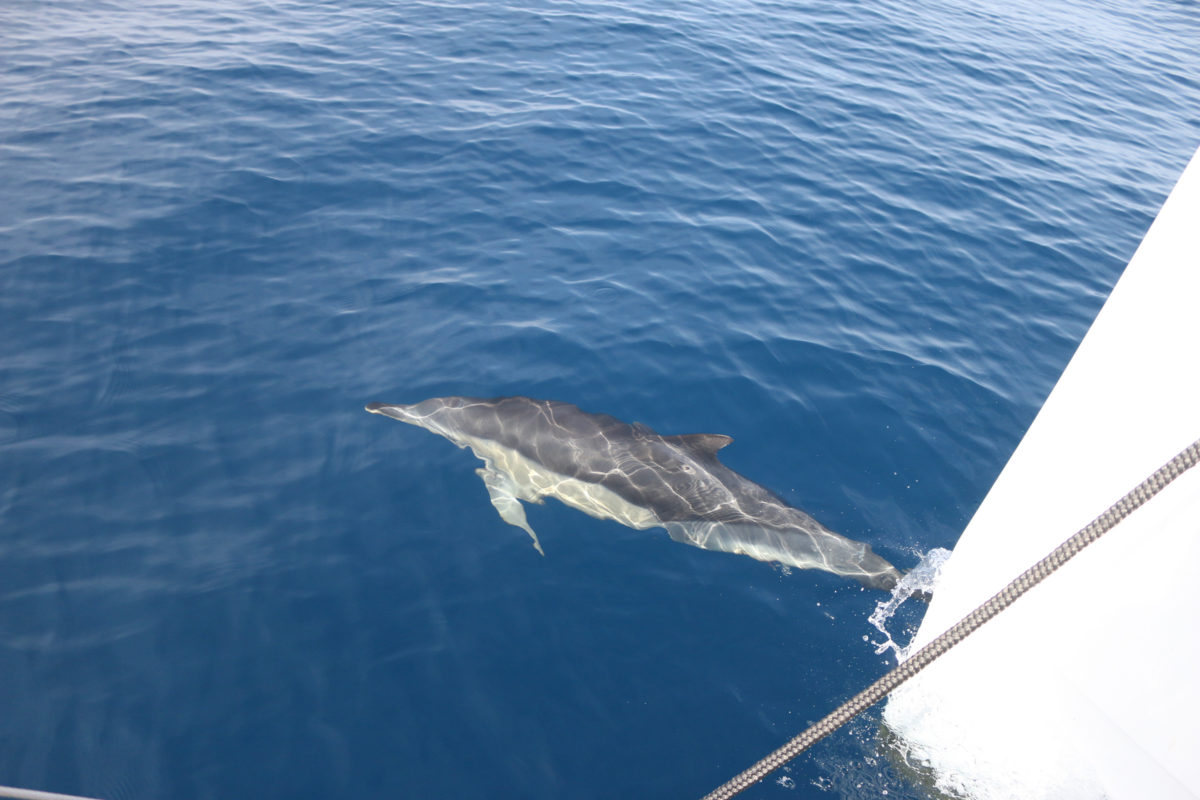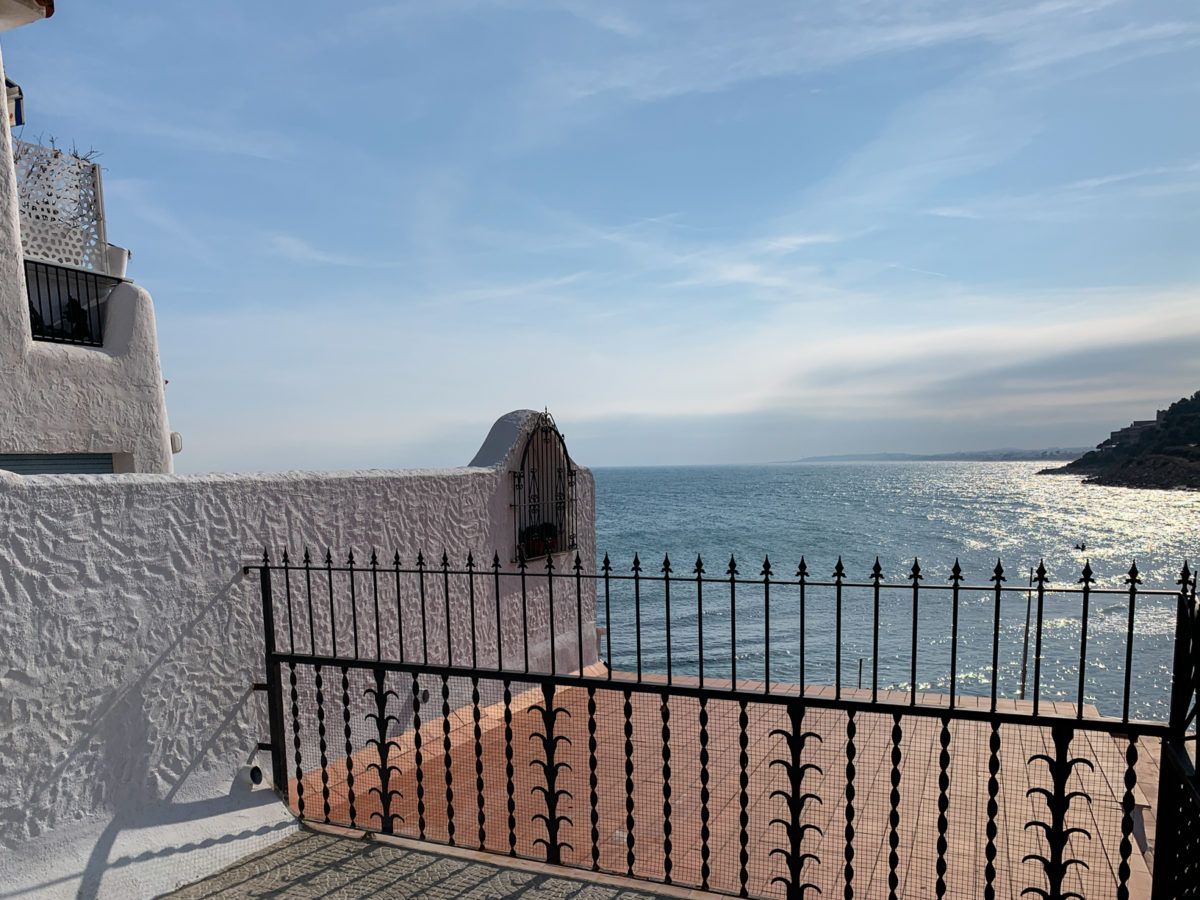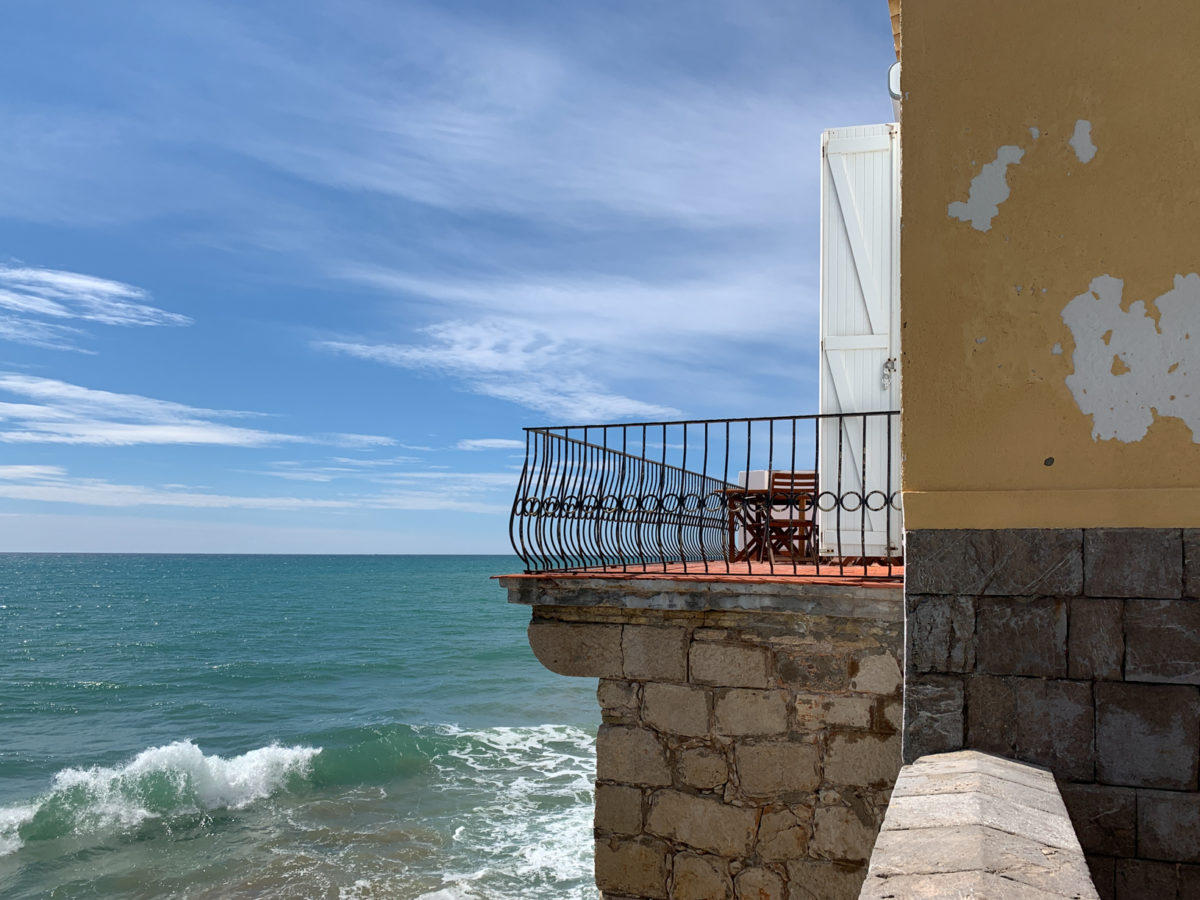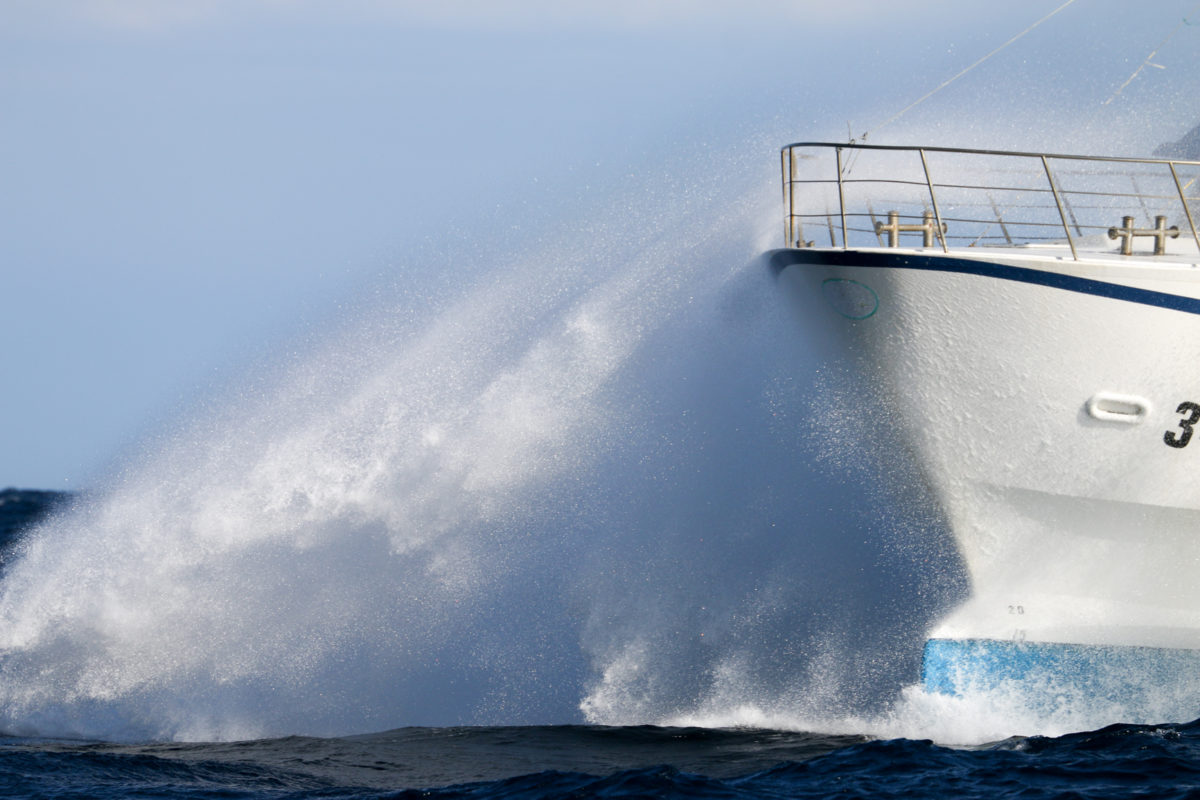Scheduled Underwater Inspection
Changing 2 sea-valves and thruhulls with a ‘problematic’ installation method. We hope to splash early next week. 

Scheduled Underwater Inspection
Changing 2 sea-valves and thruhulls with a ‘problematic’ installation method. We hope to splash early next week. 


Initially we planned to sail straight to Cartagena, Spain which is a 48hours+ trip. The weather forecast made it wise to to split the journey into two legs. Wind and waves for the second night were not what we consider nice.
I am writing part of this underway update during my night watch. It’s midnight right now (local time). By the time this blog update is published we will be in Denia.
The wind is variable from 2kts to 8kts. We have the port engine running.
It’s a very quiet watch with occasional commercial traffic. I prefer night watches with some action, as it is so much easier to stay awake.
At the moment one vessel is overtaking us. “Atlantic Island”, a small cargo vessel is catching us from behind with a 3.8kts relative speed. You can see him near the 3nm ring on the radar

But back to the beginning. In the last days before our departure we finally got some of the spare parts we needed. In the end we stayed 4 weeks in Roda de Bara and were very happy about the location, not so happy about the waiting.

The marina facility is in good shape. The people in the marina and Capitaneri are very friendly. We met some cool liveaboards on our dock. And Francis from the local chandlery is a gem. We will return one day.
We explored the nearby coastal town of Sitges, which we highly recommend, see our earlier post.
We also visited a large Cava winery. Now, for those who judge Cava by what they can buy outside Spain, please reconsider. Let me encourage you to try again when you visit Spain. We saw the cellars of ‘Freixenet’. The 1910 brickstone architecture of the vinery is set in a nice landscape and felt inviting.

Cava is the Spanish equivalent to Champagne. Beyond the budget product made for export they produce excellent brut sparkling Cavas of many varieties. Freixenet’s reception has wine tasting booths with sofas in a round setting for your group or family. Together with some plates of acorn fed Iberico ham and other tasty snacks you get a great combination to try.

Back to the boat and sailing. This morning, hours before leaving, I reinstalled the autopilot controller in the engine room. The generator is decommisioned at the moment and will not be used on this trip. Beyond the issues I found earlier, which help explain the constant overheating, I researched the problem further and believe now that we whole cooling/water supply installation is insufficient to run our genset in a healthy mode.
We epoxied yesterday the mounting plate in the engine room. Today we can mount the autopilot controller box in a solid fashion.

And while being at it, I filled all the little holes in the hull, drilled for unknown reasons by unknown technicians.

Pictured above the epoxy shop on our outside dining table. The Admiral loves it when I use here kitchen gadgets like the electronic scale for work like this.
By now we are underway to Denia. After leaving the dock it typically takes an hour to clear the deck from fenders, lines and gangway, including making everything sea-safe and hoisting the sails.

Then we further waterproof the boat from above. From an aerial view our boat looks a piece of art from a trailer park. Admiral Christo @ work!

The story is that one top window started leaking again. Duct Tape is our new friend. When I retrieved a new roll from the locker I realized that this was roll #3 which means we had already duct-taped 100meters on our boat. Later analysis in port showed that the window cutout in the deck is not 100% straight and even. When the boat flexes in waves the silicone glue must compensate the different movements by stretching. With an uneven thickness, ergo being thin in some areas, the thinner part of the silicon glue overstretches and detaches from the gelcoat and ….. we are leaking from top.
Afterwards the Admiral unfolded her favorite chair on the front deck and read a book in the sunshine.
Early morning the next day, we crossed the deepest part on this trip -1276m or 4200feet.

Later in the morning a pod of dolphins visited us for 15minutes. They swam and played around under our bow. I am not sure, but it looked like they rubbed their belly and back on the soft roundings of the bow, all while we were cruising along at 6knots


The Admiral was off watch and sleeping, so I did not want to wake her up. Last time I did this, she came out and the dolphins were gone. After a while looking at this beautyful scene under our bows I caved in and woke her up. The moment she came out – quite excited and in PJs- she could see only one dolphin far back in our wake. What shall I do next time?
As we approached Denia the ship traffic increased. See the radar from 10miles out

Denia is a ferry port and home to a small fishing fleet. The ferries go mostly to Ibiza and the Balearic Islands. Some are quite fast. When you see them on radar or get the AIS warning things happen fast. You can barely see them at 2mi away, but with a closing speed of 30kts you will be in their way in 4 minutes!
The port entrance of Denia is a narrow channel which is easy to navigate in good weather. When we left on the following day it looked quite different and more challenging.

Why we split the trip into two legs you can see here. The weather we wanted to avoid begins to roll in an hour after our arrival.

The marina is nice but pricey. The views are great, especially towards the fort. With sunshine it must be beautiful here.

In the evening we took a small free ferry across the port to go to the old town for dinner.
We found a nice grill restaurant. The food was freshly grilled in the center of the restaurant, protected by glass screens and equipped with good ventilation. Food was really tasty and the local Spanish Rose was excellent.

Tomorrow we’ll get up late and prepare to leave around 1400h heading to Cartagena. More about this in the next underway update.

Admiral fueling up.
Weather lousy.
Crossing seas with light wind and rain. Better days will come 😀.
Denia port entrance had breaking waves on each side. The middle part of the channel was fine. Outside the first hour exposed us to a heavy long swell from a gale in the east and crossing wind waves. Rain and fog with limited visibility. Sailing with intense use of the Radar. After rounding the Cape Cabo de la Nao for a westerly heading life onboard became much easier.
Arrived 1700h on Friday in Cartagena. It’s chilly here. Weather in the Med, so everyone on the dock declares, is unusually crazy.

Just some pictures from our Sunday afternoon walk. Couldn’t resist to post as it is so beautiful here.
In some days we will continue our journey towards Cartagena.




Sorry, our blog was offline yesterday night. We moved to a new hosting service.
Except for the color scheme right now, everything else should be the same as before.

(Featured image is a fishing vessel from Port Roses. Don’t worry, the photo was shot with a Telelens)
From France to Spain March 19, 2019
Our departure day has arrived. The desire to finally sail again is getting fulfilled. In the prior week we had sailed from La Grande Motte to Cap d’Agde (35nm). We got our feet wet and tested the boat.
This trip is close to 190nm and leads around Cap Creus. The cape marks the border between Spain and France and has its reputation in winter time due to the frequent, ferocious Tramontana winds. Our plan was to pick a weather window behind a front with receding winds, but still enough wind to have the boat moving. Yeah- we got the boat moving.
Weather Forecast:

Early morning 6am UTC

36 hours later. Front has receded.
The wind forecast was nearly point on. The wave forecast not so much. For the gusts above 30kts we were prepared with a 2nd reef and had our small jib ready to hoist. In the end, the wind never felt as bad as the waves, especially 50 miles south of Cap d’Agde.
We began docking off early in the morning, but needed the dinghy to get our lines off the mooring buoys. First, we helped our friends on JAMS, a new Outremer 51, to do the same. Due to the very strong winds the night before, we had changed our mooring lines from slip through to just being tied with a bowline hitch to the mooring balls. Chafing was our main concern.
The first stretch we had planned to sail together with JAMS, who were heading to Port Vendres in France. It took more than an hour to get the mooring lines sorted out and the dinghy hoisted again. At 0930h we finally left port. The sun was shining brightly as we maneuvered out of Cap d’Agde. We noticed how slow our boat was moving due to the marine growth on the hull under water. This is caused by our long times staying in port. At 2000 rpm, on one engine, we had lost around 1 kts boat speed – down from 6.2 to 5.2kts.
In fresh wind (20kts+) we hoisted the main with a second reef and unfurled the genoa for a nice downwind heading. Soon both boats, Lunara and JAMS, sailed at double digit speeds.
The first two hours sailing were great, but the more we moved away from land the stronger the wind became and the longer fetch of free water allowed the waves to grow. The Admiral became crabby, she got the (sea) flue.

Waves in photos always look puny compared to reality. By this time we were sailing constantly 10kts+
Initially it was warmer and quite sunny. Never forget, it’s still winter.

Under way in the Golf du Lion. A bit later we encountered 35kts winds from behind and pretty good waves.

When my watch came up the temperature had dropped to 10°C. I am dressed for the occasion.
As we rounded Cap Creus, we had averaged 10.5kts and hit a top speed of 17 kts. The tripmeter’s 8.4kt average (picture below) requires an adjustment for the hour or more spent leaving the dock and raising the main sail. We were quite impressed, considering that the hull has a lot of drag from the marine growth.
10 hours into the trip, past Cap Creus, we met some fishing vessels heading home to Port Roses.

Fishing vessel south of Port Roses. This guy came very close and ignored us completely. He was crossing us head on a collision course. We took avoiding action.

This captain changed course early, to pass neatly behind our stern at a good distance.
Mid evening we passed a former dock neighbor from La Grande Motte ‘Orialine’ (Outremer 51). I just got a shot from very far away.

Night broke, the wind receded to a tad above 20 knots. Boat speed was an easily manageable 7 kts. The Admiral was still out of commission.
 No worries, as we planned to stay in deep water passing Barcelona 10 miles to the south. Started charging the batteries with the generator. After 60 minutes the generator …..
No worries, as we planned to stay in deep water passing Barcelona 10 miles to the south. Started charging the batteries with the generator. After 60 minutes the generator …..

Generator Control
…said adios amigo. Not really surprising, except it is the second, replacement generator and had less than 10 hours runtime. Upon arrival I inspected all the possible reasons for overheating and found some 🙁
The fuel pump was installed horizontal (should be vertical), which creates bubbles in the diesel and a lean fuel mix for the generator leading to overheating. Second, upon taking the water filter apart (yes, I checked the impeller pump first), I found an installation novelty: Sikaflex (silicone sealing) in the filter intake and output. Why? The filter was not meant for generators, had conical connections and the flat hose connectors do not fit a conus- obviously. So, a lot of Sikaflex was used to make it fit. Some people, please don’t call them marine professionals, should never have access in their life to either Duct-tape or Sikaflex. It should be a controlled substance and subject to something similar to a firearms permit!

Water strainer input and output looked like this!
Anyway, I ordered a proper water strainer which took 2 weeks to get here and will install it tomorrow.
Now, we run the engines to charge the batteries – yes, you guessed it right – something else happens. An Volvo engine control alarm with a piercing loud beeping signals alerts us that one of the smaller 60A alternators is charging with 15V. The electrician company later commented ‘Don’t worry, the 15V won’t reach your batteries’ Great, a) why does Volvo programmed this alarm? b) how do you sail/live with a 110dB alarm? What are my options? Not using the engine?
See ‘ALT STARBOARD R’ 15V in the picture.

Around midnight we began passing Barcelona. The town and coastline is well lit. Not much ship-traffic at this time as most ferries, cruise- and cargo ships seem to want to stay in port during night. When we had nearly passed Barcelona, at 0500h, the traffic awoke and we had to dodge a lot of the bigger guys.
The night was beautiful with clouds alternating with a full moon. Even the Admiral, in her sad state with a flu, enjoyed the view. The full moon set precisely at the time when in the east the sun was rising – magical. We sailed and motored on towards our destination Roda de Bara to arrive their early afternoon.
I was a bit exhausted, as I had been on watch most of the last 36 hours. 5 miles away from port we lowered the sails and set the autopilot on a NW course for the port entrance. We motored slowly with one engine a little above idle rpm, so that I could get an urgently needed nap for 45 minutes. I don’t like to drive into a foreign port super tired. Even a short nap works wonders (thanks Andrew for the tip!)
Upon arrival and after a messy fight with the dirty mooring lines I got our little electric scooter out on the dock and checked in at the Capitanerie. The gentlemen managing the marina is a very nice former east German navy officer. He remembered all the west German navy’s surveillance ships by name – the ones I had sailed on in the 70s. You can imagine we had a nice long check-in chat 🙂
Late next morning, after a good sleep, I inspected the boat and found some more installation defects and deficiencies. The port side main bilge pump was damaged. Someone had stepped on it most likely during the water maker repair. Two notches of the casing were broken off. The pump was sitting loose and the impeller chafed in the housing. Ordered a replacement (160 Euro!) and installed it.

Damaged Bilge Pump
Upon repair I found the pumps electrical wires had several cuts and corrosion had set in (not visible from the outside). So I replaced a longer stretch of the cable as initially planned 🙂 the joys of boat owner ship!

Port bilge pump wiring damaged. No longer waterproof.
Then working on the generator overheating issue I discovered another installation no-no. The base plate of the throughull for the generator is mounted partially free floating and not fully painted, hence, not waterproof. Ultimately, the wood will rot and cannot support the pressure from the tightened throughull. Even today, it is a compromised installation. Will haul out in Cartagena (next port) and replace!
Further, one disconnected electrical wire from one alternator (not the overcharging alternator) was hanging loosely in the bilge touching the water 🙁 Have to check if it’s still hot, as this wire was prior used to signal the house battery voltage to the alternator.
In the port engine room the B&G autopilot controller fell of the hull. It was improperly glued/Sikaflexed to the hull (see prior post). You can have some fun with this stuff – see picture below.

The SIKA man
is remarkably warmer than Southern France at this time of the year. Less wind and 300 days sunshine is more than good enough for us! Roda de Bara is quiet and idyllic in a positive way, but also means less restaurants being open during winter (nearly none during the week).

El Roc de Saint Gaieta
Some impressions of this very nice beach town:

This stretch of the coastline is part of the Via Augusta, built in 10BC

El Roc de Saint Gaieta

El Roc de Saint Gaieta

El Roc de Saint Gaieta

El Roc de Saint Gaieta

Vitamins! Banana Split.

Super clean water in the marina

Roda de Bara Marina

Marker on seawall
Ah yes, the food: Carnivores do not suffer in Spain. This is the Lidl supermarket with a great selection of local Iberico ham:

This was a long post, but fun to write. If you made it until here you deserve a glass of Rose!
Cheers!